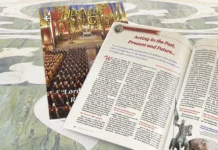The proper reading of the Bible constitutes one of the great challenges for modern man, dominated by a positivistic and materialistic mentality. However, the teaching of the Church offers a sure solution to this problem.
It was the year 1947, when some Bedouins were wandering through the mountainous regions of Israel, twelve kilometres south of Jericho, in search of a lost animal. Exhausted by the scorching sun, they came across a cave, which seemed an appealing place to rest from their fatigue. In this fortuitous fashion, they made what some call the greatest archaeological discovery of the 20th century.
Amidst the wars and political tensions that engulfed the territories of the West Bank, the eyes of the world turned, for a moment, to the Judean desert; the region of Qumran. Over the course of nine years, excavations and research in eleven caves brought to light nine hundred and thirty ancient manuscripts dating from 250 BC to 68 AD.
Faced with the new horizon that was opening up for archaeological research, with serious and inevitable repercussions of a historical and religious nature, Public Opinion was divided into at least three positions. Some wanted to discredit the biblical truths with these discoveries. Others saw in them the opportunity to empirically prove the authenticity of the sacred texts. And a third group showed no interest in the fact, because archaeology did not seem to them to be of any use for exegetical study.
Among which group should Catholics have numbered?
Let us leave aside the story of the Bedouins of the West Bank for a moment and turn our eyes to our Faith, so attacked, misunderstood and despised by the men of our time.

The Word of God put to the test by science
The contemporary mentality is undeniably saturated with materialism, touting the belief that all truth is reducible to the scientific and pragmatic verification of objects. Such is the concept of “freedom of thought” defended by the Enlightenment and positivism – and made explicit in the religious sphere by the modernist heresy – according to which “the dogma or doctrine of the Church appears as one of the real obstacles to a correct understanding of the Bible.”1
But this crisis is not as recent as it may seem at first sight. Let us look in a few broad strokes at the long process responsible for extinguishing the beautiful light of past exegesis.
The changes that have affected society since the 15th century have had a profound and radical influence on man’s interior life, reaching an almost inaccessible recess: the loving relationship between the soul and its Creator.
These transformations led men like Richard Simon to no longer consider the Scriptures as Divine Revelation authored by the Holy Spirit, a belief that seemed to him to belong to a contemptible past. For him, the Bible was a conglomeration of heterogeneous texts, written by diverse authors, and which had to be explained in their literal and critical sense.2
The new perspective was reinforced by a historical innovation in Western thought: the scientific spirit. At the beginning of the 18th century, strictly scientific reason and criticism took over the reins, so to speak, of the study of Sacred Scriptures. There was a search for explanations about the “sources” and the “literary genres” of the biblical books, in order to deduce the historical process of their composition.
And there were inevitably those who exploited this method to militantly attack the Sacred Books, like Robert Challe, who claimed that there was nothing so badly written as the Bible, full of useless repetitions and contradictions.3
This trend seemed promising to spirits eager for revolutions, for it opened the door to innovative interpretations of those texts shrouded in mystery, setting aside the monotonous traditional hermeneutics and embracing “the effort to establish, in the field of History, a level of methodological precision that would lead to conclusions having the same certainty as those in the natural sciences.”4
Thankfully, however, Pope Leo XIII condemned these deviations, calling them an artifice introduced perversely, “to the great detriment of Religion,” by which one presumes “to judge of the origin, integrity and authority of each Book from internal indications alone.”5
The Concordist current
In the 19th century, another current emerged, seeking a scientific and natural concordance for all biblical events. It was known as concordism.
Werner Keller’s introduction6 in his book The Bible as History is a typical expression of this approach. According to him, much of the data discovered through archaeological research changed the way the Bible is regarded: from simple “pious stories”, the Sacred Book took on a new stature, to be considered a text about real events.
An example will better illustrate this tendency.
The biblical account gives a detailed description of the taking of Jericho by the children of Israel at Yahweh’s command (cf. Jos 2:1-6:25). The ruins of this ancient city can be found at Tell es-Sultan and have become, since the beginning of the last century, the stage for intensive excavations, theories and denials…
Between 1907 and 1909, the work was in the hands of Ernst Sellin and Carl Watzinger, who declared that a great wall discovered in a state of demolishment would have fallen in the year 1200 BC, the time when Joshua took the city. More precise research was set in motion under the direction of John Garstang, who found traces of fires and collapsing structures. His conclusions leaned towards the destruction of the walls in the year 1400 BC. Other studies were directed by the archaeologist Fr. Hughes Vincent, but the British Kathleen Kenyon had the distinction of concluding: the walls of Jericho had been rebuilt seventeen times during the Bronze Age, as they were often destroyed by earthquakes or erosion.
The concordist interpretation then inferred: “Perhaps this poor resistance of the walls was echoed in the legend transmitted by the Bible, which tells how the children of Israel only had to raise their battle cries and blow their trumpets to conquer Jericho.”7
Where then, was the hand of God, to powerfully save His chosen people? Would the Bible be a narrative of historical and human facts, covered by a veil of religion, the fruit of superstitions and antiquated beliefs?
Clearly, the answer is no… The scientific study of the historical facts narrated in the Holy Scriptures must limit its conclusions to its own particular scope.
The “hand of God” is not measured by inches, the breath of the Holy Spirit does not generate wind energy and the Bible is not a science book!… We must humbly admit: not all truth can be verified in a laboratory or on an archaeological site, and even less so by the unilateral opinion of a scientist.
A Theology detached from exegesis
With so many and such contradictory theories about the Bible, some theologians chose to distance themselves from the confusion, “in search of a Theology that was as independent as possible from exegesis.”8 They sought to take the Holy Scriptures in their literal purity, excluding any attempt at historical understanding.
This, once again, is a deviation. According to a document of the Pontifical Biblical Commission, this current, called fundamentalism, imposes a reading of the sacred text “that rejects all questioning and all critical research,”9 not accepting that it has been expressed in a human language, by human authors, of limited capacities and resources. “Accordingly, it tends to treat the biblical text as if it had been dictated word for word by the Holy Spirit and does not recognize that the Word of God was formulated in a language and phraseology conditioned by one era or another.”10
The Church’s response in face of the crisis
If fundamentalism, the strict historical-critical method and concordism constitute improper approaches to the Sacred Scriptures, what is the proper position before the Word of God?
In the first place, we must admit that the Bible is not an ordinary book, written to relate the history of a people or a man mythified by the beliefs of highly religious communities. Not at all! It contains an incomparable treasure: the revealed and written Word of God.11
It is revealed because God willed to manifest Himself, making known to men the mystery of His will (cf. Eph 1:9). Therefore, we must venerate all that the Bible affirms as words from the Holy Spirit. According to the Magisterium of the Church, “we must acknowledge that the books of Scripture firmly, faithfully and without error teach the truth which God, for the sake of our salvation, wished to see confided to the Sacred Scriptures.”12
Our assurance is based on the theological virtue of faith, as a filial and obedient response to God who reveals Himself, with “full adherence of intellect and will,”13 opening the mind and heart to the action of the Holy Spirit.14
Divine Revelation is the manifestation of God’s love, and love is not proven by scientific experiments or critical reasoning methods. This would be equivalent to wanting to measure the affection of a mother for her son or of a husband for his wife through some laboratory instrument.
Moreover, the Bible is the written Word of God. The Holy Spirit employed men as material instruments, who, by divine inspiration, wrote the message of salvation, each one with his own faculties and capacities.15
From this perspective, scientific study assumes an important role, together with exegetical hermeneutics.
The historical-critical method and archaeological research have the task of helping the exegete to understand the historical contexts, the mentality of the time, the customs in force and the idioms which contribute to a deeper understanding of the Sacred Scriptures.16
Nevertheless, such a study can never decide on the veracity of the Word of God or on the value of Revelation, whose interpretation belongs, by divine mandate, to the Holy Catholic Church.17
And what about the inaccuracies in the Bible?
A problem arises here: sacred text contains certain inaccuracies and even contradictions.
Let us consider an example. When the Evangelist St. Matthew describes the Sermon on the Beatitudes, he states: “Seeing the crowds, He went up on the mountain…” (5:1). St. Luke, however, tells the same story in a different way: “And He came down with them and stood on a level place…” (6:17).

Where did the sermon take place? On a mountain or on a plain? Did the Divine Redeemer go up or come down before pronouncing those words which have impressed the centuries by the wisdom and goodness with which He addressed the afflicted and persecuted?
Explanations may multiply, seeking an allegory or a lapse in the human aspect of the person who wrote the Gospel account. It is up to exegetes to study the case with rigorous scientific methods.
However, as regards the revealed truth necessary for our salvation, there is no error or disagreement between the texts because, whether on the mountain or on the plain, the substance of the divine message does not suffer distortion. In this regard, it is fitting to recall the words of St. Augustine: “The Spirit of God, who spoke through them, did not wish to teach men such things as do not profit them for their future salvation.”18
The same occurs when in the Holy Scriptures an attempt is made to explain a physical or natural fact. In this case, rather than making a detailed investigation of the universe, the sacred authors describe and deal with these topics by way of metaphor or as popular language expresses what is perceived through the senses – as St. Thomas Aquinas observed19 when commenting on the Book of Genesis – in order to convey what God wished to teach for our salvation.20
Obedience of faith together with science

After this brief historical and doctrinal overview, let us briefly consider the outcome of the event which gave rise to this article: the discoveries made in the region of the Dead Sea and their impact on the biblical texts of the New Testament.
It is the opinion of many scholars that the research did not affect the understanding of the texts and Divine Revelation, nor did it produce discoveries which required the revision of any point of the Christian Faith.21
However, impressive similarities in vocabulary, customs, and eschatological convictions between the writings of the New Testament and the Qumran manuscripts shed light on a relationship between the early Christians and the community that inhabited those regions.22
In short, the studies have contributed to forming an unprecedented idea about part of the society at the time of Jesus, adding precious information to the historical context of the sacred texts. But they could not change what concerns the message of Faith taught by the Church.
The scientific method stands, therefore, as an effective instrument for exegetical development, as long as it is in harmony with faith, safeguarded by Holy Mother Church. Exegesis, for its part, depends to a great extent on science, in the understanding of historical and sociological contexts, in order to complement its research on the Sacred Books.
Like two wings, faith and reason unite under the guidance of the Holy Church, in order to lead man to the knowledge and possession of eternal life. ◊
Notes
1 RATZINGER, Joseph. Interpretação bíblica em crise: sobre a questão dos fundamentos e abordagem da exegese hoje. In: LA POTTERIE, Ignace de et al. Exegese cristã hoje. Petrópolis: Vozes, 1996, p.111.
2 Cf. GIBERT, SJ, Pierre. Petite histoire de l’exégèse biblique. De la lecture allégorique à l’exégèse critique. Paris: Du Cerf, 1997, p.213-215.
3 Cf. Idem, p.223-224.
4 RATZINGER, op. cit., p.118.
5 LEO XIII. Providentissimus Deus: DH 3286.
6 Cf. KELLER, Werner. E a Bíblia tinha razão. São Paulo: Círculo do Livro, 1978, p.18-19.
7 Idem, p.179-180.
8 RATZINGER, op. cit., p.113.
9 PONTIFICAL BIBLICAL COMMISSION. L’interpretation de la Bible dans l’Eglise. In: FILIPPI, Alfio; LORA, Erminio (Ed.). Enchiridium Biblicum: Documenti della Chiesa sulla Sacra Scrittura. 3.ed. Bologna: EDB, 2004, p.1258.
10 Idem, ibidem.
11 Cf. SECOND VATICAN COUNCIL. Dei Verbum, n.9: DH 4212.
12 Idem, n.11: DH 4216.
13 FIRST VATICAN COUNCIL. Dei Filius: DH 3008.
14 Cf. BENEDICT XVI. Verbum Domini, n.25.
15 Cf. SECOND VATICAN COUNCIL. Dei Verbum, n.12: DH 4218.
16 Cf. PIUS XII. Divino afflante Spiritu: DH 3831; SECOND VATICAN COUNCIL. Dei Verbum, n.12; 23: DH 4217-4218; 4230.
17 Cf. FIRST VATICAN COUNCIL. Dei Filius: DH 3007.
18 ST. AUGUSTINE OF HIPPO. De Genesi ad litteram. L.II, c.9, n.20. In: Obras. Madrid: BAC, 1957, v.XV, p.645.
19 Cf. ST. THOMAS AQUINAS. Summa Theologiæ. I, q.70, a.1, ad 3.
20 Cf. LEO XIII. Providentissimus Deus: DH 3288.
21 Cf. VANDERKAM, James C. Os manuscritos do Mar Morto e o Cristianismo. In: SHANKS, Hershel (Org.). Para compreender os manuscritos do Mar Morto. Rio de Janeiro: Imago, 1993, p.192-193.
22 Cf. Idem, p.194-211.







